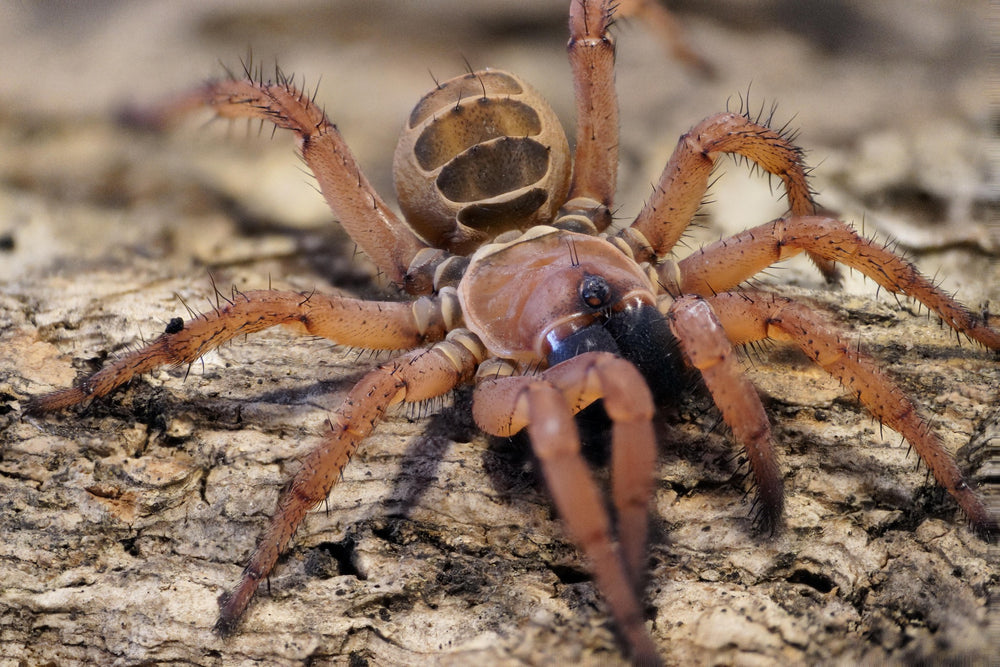
Pterinochilus murinus 'Usambara' (Orange Starburst Baboon) 0.5" | 2" | MM
- Live Arrival Guarantee
- Live Animals Ship FedEx Priority Overnight (Mon-Weds)
- In stock, ready to ship
- Inventory on the way
The Usambara Mountains Variant (UMV) of the Orange Baboon Tarantula (OBT) Pterinochilus murinus Pocock comes from the region of Usambara mountains of Tanzania. It can be distinguished from other forms of P. murinus by having a mature coloration of intense fiery Cheetoh orange- a truly show-stopping spider that is also flavor-blasted in terms of attitude. This form reaches a leg span of four to six inches and bears some resemblance to those suction-cup footed Garfield stuffed animals you see in cars.
Similarly to other OBTs that belong to the African baboon spider subfamily Harpactirinae, these spiders have a jet black exoskeleton that is adorned with a velvet-like pelt of intensely colored hairs. All P. murinus are sleek, elegant, and fast spiders, having a dramatic starburst pattern on the carapace consisting of streaks of velvet-like setae interrupted by hairless grooves in which the shiny black carapace is visible. The abdomen is also clothed in a velvet-like pelt with a minimalist herringbone-like chevron of short streaks and spots overlain on a motif of stippled bean-shaped flecks of lighter colored setae. The legs resemble baboon fingers (their namesake) with brightly colored stripes at each joint. The posterior surface of the legs and body are jet black.
OBT forms are currently all grouped under P. murinus, however, together, these spiders encompass a vast biogeographic range across most of the southern half of the African continent. It is possible that P. murinus is a complex- having multiple species or subspecies grouped under one name that may yet be split by taxonomists. However, for now, the trade names and their abbreviations are the way arachnoculturists are maintaining records and it is important to maintain that data when working with these spiders.
Regardless of the disparity in their ranges, the different forms of OBTs have generally similar ecologies and behavioral traits. They all are highly adaptable to a wide range of tropical dryland to forest environments. In the wild, these baboon spiders construct earthen burrows in dry clay or silty substrates or make subarboreal retreats toward the bases of dense scrub, or under brush piles, rocks, logs and debris. They have adapted to a wide range of elevations (sea level to 2,100m) and humid to semi-humid climates, but all can take surprisingly dry conditions.
If you have never raised an OBT before, you are seriously missing out. P. murinus is the easiest tarantula on Earth to raise as they are unrealistically resilient to just about anything life throws at them. These are not high maintenance beauties. They live life in the fast lane and do everything to the extreme. P. murinus are highly defensive spiders equipped with strong venom for a tarantula. You will not be handling this spider.
However, their dynamic defense displays are truly epic– complete with stridulating (hissing) through rubbing specialized ridged and grooved structures on parts of their body together. Even spiderlings will sometimes throw the cutest threat display you will ever see. The stridulation of OBTs is also fun: it sounds exactly like the fizzing of a carbonated beverage echoing throughout their enclosures- and a spicy soda this is! They can remain in a defensive position for comically long–sometimes a half hour after their keeper has left the room. OBTs move lightning fast and have serious spunk, so keep your hands clear of the cage.
In addition to their defensive maneuvers, these adrenaline junkies are insane webbers, rapidly lining the entirety of their enclosures in thick sheets of silk, constructing several stories of passageways and tunnels throughout. They are fearless predators with a bottomless stomach and grow incredibly fast. Feeling full? These just shed and level up a size.
As mentioned, these spiders are highly resilient and adaptable. Spiderlings require a bit of moisture in their substrate but juveniles to adults thrive best in well-aerated terrestrial enclosures on bone dry substrates. They should be maintained with only periodic mistings and the substrate should always be allowed to dry fully between. To top everything off, OBTs are wonderfully prolific and easy to breed. So if you have been wanting to try your hand at captive breeding tarantulas, P. murinus is a great species to attempt. All in all, the UMV of P. murinus is a stunning spider with plenty of attitude that deserves a special place in every collection.
References:
Pocock, R.I., 1897, October. On the Spiders of the Suborder Mygalomorphse from the Ethiopian Region contained in the Collection of the British Museum. In Proceedings of the zoological Society of London (Vol. 65, No. 3, pp. 724-774). Oxford, UK: Blackwell Publishing Ltd.
https://arachnoboards.com/threads/colour-variants-of-pterinochilus-murinus-by-locality.301990/
https://thespidershop.co.uk/product/pterinochilus-murinus-dcf-2/

Info on our shipping policy can be found on our T&C page.



